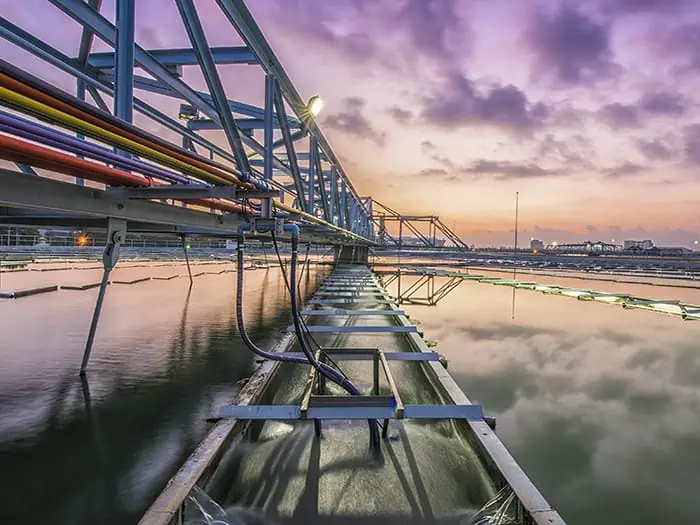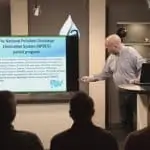


The Clean Water Act (CWA) specifies various technology-based Effluent Limitations Guidelines (ELGs) for direct and indirect dischargers. These ELGs include:
EPA evaluated available technologies to treat or remove meat and poultry (MPP) pollutants individually and in treatment trains, as shown below in subsections, based on the type of pollutant removal, including conventional pollutants, phosphorus, nitrogen, pathogens, and chlorides.
Conventional Pollutant Removal
MPP process wastewater contains oil & grease, TSS, and BOD, all conventional pollutants removed with primary treatment, which removes floating and settle-able solids. Typical treatment technologies include screening and DAF.
Facilities may add polymers, flocculants, and phosphorus-precipitating chemicals to or before the DAF. The chemical addition increases the removal of pollutants from the wastewater. Adding chemicals to remove phosphorus can help facilities meet phosphorus effluent limits. Chemical addition may not be possible for facilities that recycle materials from the DAF to the facility, as this would contaminate the raw material.
Biological/Organic Pollutant Removal an Attractive Option
Biological, physical, and chemical processes remove BOD, nitrogen, and phosphorus. Biological processes are useful to achieve low levels of BOD and nitrogen and are common at MPP facilities. Microorganisms in biological wastewater treatment require phosphorus for cell synthesis and energy transport, typically removing 10 to 30 percent of influent phosphorus. Through biological treatment, organic compounds break down with bacteria into water, CO2, N2, and CH4 products.
Biological treatment systems are often used in series to achieve high nitrogen removal rates. Wastewater flows from one system to the next, with recycle streams and returned activated sludge returning to various system locations. Some examples include:
iii. Modified Bardenpho: This is a five-stage process: anaerobic, anoxic, aerobic, anoxic, aerobic, followed by a secondary clarifier. As in the Bardenpho process, mixed liquor with high nitrate levels is recycled from the first aerobic stage to the first anoxic stage, and activated sludge from the clarifier is recycled back to the influent. The anaerobic stage at the beginning of the system results in biological phosphorus removal. Phosphate-accumulating organisms (PAOs) are recycled from the aerobic stage in the mixed liquor to the anaerobic stage. In the following aerobic stages, PAOs uptake large amounts of phosphorus.
Phosphorus Removal
As mentioned in the biological/organic pollutant removal section, some phosphorus is removed in biological treatment processes. Chemical addition and/or tertiary filters achieve low phosphorus levels.
Pathogen Removal
Disinfection destroys remaining pathogenic microorganisms and is generally required for all MPP wastewater discharged to surface waters. Chlorination/dechlorination, Ultra-Violet (UV), and some filters can meet effluent limits for pathogens and inactivate pathogenic microorganisms before discharge to surface waters.
Chloride Removal
Some MPP processes, including hides processing, meat and poultry koshering, and further processing techniques, such as curing, brining, and pickling, commonly produce wastewater streams with high levels of chlorides. Some facilities use water softening, which can also produce high chloride wastestreams. Wastewater treatment technologies commonly found at POTWs and many MPP facilities do not remove chlorides. The optimal chloride treatment technologies for a facility depend on wastewater strength, climate, land availability, and cost. High chloride wastestreams may be able to be separated from other wastestreams, which can reduce costs and energy required for treatment.
Solids Handling
Some wastewater treatment technologies produce industrial sludge. In the MPP industry, DAF and clarifiers primarily generate sludge. The sludge contains oil & grease, organic materials, nitrogen, phosphorus, and chemicals/polymers added in the treatment system. The sludge may have a high water content, which can be reduced to reduce volume and save on hauling and landfilling costs. Common dewatering technologies include gravity thickening units and the belt filter press. The sludge may be incinerated, land applied, or landfilled, depending on state, local, and federal regulations and disposal method availability.
Additional Information About PFAS Removal – Foam fractionation is a separation process that leverages the affinity of certain molecules for the air-liquid interface to isolate and concentrate them. It works by bubbling gas through a liquid, causing the target molecules to adsorb onto the surface of the bubbles and rise to the top, forming a foam that is removed. This process is useful for removing and concentrating per- and polyfluoroalkyl substances (PFAS) from water and wastewater.
EPA announces final rules intended to reduce pollution from fossil fuel-fired power plants, which the Agency claims will not disrupt reliable electricity delivery. These rules, finalized under separate authorities including the Clean Air Act, Clean Water Act, and Resource Conservation and Recovery Act, aim to reduce climate, air, water, and land pollution from the power sector.
The power sector has been investing long-term to transition to a clean energy economy based on rule changes like those recently announced by the EPA. This technical compliance alert summarizes four key rule changes, including:
Clean Air Act – NSPS
40 CFR Part 60
EPA Fact Sheet: https://www.epa.gov/system/files/documents/2024-04/cps-111-fact-sheet-overview.pdf
Clean Air Act – MATS and TRI
The EPA is updating the Mercury and Air Toxics Standards (MATS) for coal- and oil-fired power plants to reduce hazardous air pollutant (HAP) emissions, with standards reflecting the latest advancements in pollution control technologies.
The final rule reduces the mercury emissions limit last set in 2020 by 70 percent for lignite-fired units and reduces the filterable particular emissions limit (a surrogate for other toxic metals) by 67 percent for all coal plants—while also requiring the use of continuous emission monitoring systems to provide real-time, accurate data to regulators, facility operators, and the public to ensure that plants are meeting these lower limits and that communities are protected year-round from pollution exposure.
For more information: https://www.epa.gov/stationary-sources-air-pollution/mercury-and-air-toxics-standards
Clean Water Act – Effluent Limitations Guidelines (ELG)
40 CFR Part 423
Wastewater discharge standards that apply to coal-fired power plants under the Clean Water Act are intended to reduce the possibility of toxic metals and other pollutants in wastewater entering lakes, streams, and other water bodies.
EPA’s final rule establishes technology-based discharge standards—known as Effluent Limitation Guidelines and Standards (ELGs)—that apply to four types of wastewater:
Recognizing that some coal-fired power plants are in the process of closing or switching to less polluting fuels such as natural gas or renewable natural gas, the regulation includes flexibilities to allow these plants to continue to meet the 2015 and 2020 regulation requirements instead of the requirements contained in this final regulation. The EPA is creating a new subcategory for energy-generating units (EGUs) that permanently cease coal combustion by 2034.
EPA Fact Sheet: https://www.epa.gov/system/files/documents/2024-04/steam-electric-final-rule-fact-sheet_508.pdf
RCRA – Coal Ash/CCR Disposal and Impoundments
40 CFR Part 257
Under the Resource Conservation and Recovery Act, EPA is finalizing a rule for controlling and cleaning up contamination from the disposal of coal combustion residuals (CCR), or coal ash. The Agency is finalizing regulations for managing coal ash at inactive surface impoundments at inactive power plants and historical coal ash disposal areas. Inactive coal ash surface impoundments at inactive facilities are called “legacy CCR surface impoundments.”
This final rule extends a subset of EPA’s existing CCR requirements to these historic disposal units to remediate contamination and prevent further impacts. These requirements apply to all active and inactive facilities with legacy CCR surface impoundments. EPA is strengthening established groundwater monitoring, corrective action, closure, and post-closure care requirements for CCR management units (regardless of how or when that CCR was placed) at regulated facilities.
This rule becomes effective six months after publication of the final rule in the Federal Register. The compliance deadlines in the final rule provide additional time beyond the effective date for facilities to comply with certain technical criteria based on the amount of time EPA projects that facilities need to complete them, such as installing a groundwater monitoring system or developing a groundwater sampling plan and analysis program.
EPA Fact Sheet: https://www.epa.gov/system/files/documents/2024-04/legacy_ccrmu_final-_fact_sheet_april2024.pdf
Power Sector Compliance, Operations, and Reporting Resources:
EPA is issuing a new Clean Water Act (CWA) rule that requires certain facilities to prepare and implement facility response plans (FRP) that address the storage and worst-case discharge of hazardous substances (HSs).
According to the EPA, the facility response plan requirements apply to facilities that could reasonably be expected to cause substantial environmental harm based on their location. These include facilities with a maximum onsite quantity of a CWA hazardous substance that meets or exceeds threshold quantities, located within a 0.5-mile radius of navigable water or conveyance to navigable water, and meets one or more substantial harm criteria.
From EPA’s site: See CWA Hazardous Substance Facility Response Plan Applicability.
Facilities may be identified as posing substantial harm either through a self-identification process or a process whereby EPA Regional Administrators may assess facilities on a case-by-case basis and, if appropriate, require a facility to develop a response plan based on, among other things, concerns related to potential impacts of a worst-case discharge on communities with environmental justice concerns.
The CWA hazardous substance FRP requirements apply to facilities that:
EPA estimates that the rule will impact 12,618 facilities, including 7,264 estimated for rule familiarization and the Substantial Harm Certification Form, and 5,354 facilities further developing and maintaining FRPs under the final rule.
Facilities will be required to submit FRPs to the EPA within three years of the new rule’s effective date.
Here is the link for the EPA webpage: https://www.epa.gov/hazardous-substance-spills-planning-regulations/final-rulemaking-clean-water-act-hazardous
And here is the link for the pre-publication of the Federal Register notice for the new rule: https://www.epa.gov/system/files/documents/2024-03/cwa-hs-frp-final-rule-pre-publication_.pdf
May 27, 2021, from two separate U.S. Environmental Protection Agency (EPA) announcements:
EPA intends to reconsider and revise the 2020 CWA Section 401 Certification Rule
Congress provided authority to states and Tribes under CWA Section 401 to protect the quality of their waters from adverse impacts resulting from federally licensed or permitted projects. Under Section 401, a federal agency may not issue a license or permit to conduct any activity that may result in any discharge into navigable waters unless the affected state or Tribe certifies that the discharge is in compliance with the Clean Water Act and state law, or waives certification.
EPA intends to reconsider and revise the 2020 CWA Section 401 Certification Rule to restore the balance of state, Tribal, and federal authorities while retaining elements that support efficient and effective implementation of Section 401. While EPA engages with stakeholders and develops a revised rule, the 2020 rule will remain in place. The agency will continue listening to states and Tribes about their concerns with implementing the 2020 rule to evaluate potential administrative approaches to help address these near-term challenges.
The agency’s process of reconsidering and revising the 2020 CWA Section 401 Certification Rule will provide an opportunity for public and stakeholder input to inform the development of a proposed regulation, and will include sustained dialogue with state and Tribal co-regulator partners and local governments around these issues. EPA will begin a stakeholder engagement process in June to hear perspectives on this topic and how to move forward. More information will be available at: www.epa.gov/cwa-401.
EPA, Region 7, public listening sessions on the RMP Rule
Section 112(r) of the Clean Air Act Amendments requires EPA to publish regulations and guidance for chemical accident prevention at facilities that use certain hazardous substances. These regulations and guidance are in the Risk Management Plan (RMP) rule, which requires facilities using extremely hazardous substances to develop a Risk Management Plan that:
These plans provide information to local fire, police, and emergency response personnel to prepare for and respond to chemical emergencies in their community.
The Region 7 EPA announced two upcoming virtual public listening sessions on the Agency’s Risk Management Plan (RMP) rule. The RMP rule has been identified as an action for review under Executive Order 13990: Protecting Public Health and the Environment and Restoring Science To Tackle the Climate Crisis.
The listening sessions will give people the opportunity to present information, and provide comments or views pertaining to revisions made to the RMP rule since 2017. The Occupational Safety and Health Administration (OSHA) will also participate in the listening sessions and receive comments on their Process Safety Management (PSM) standard, which contains similar requirements to the RMP rule.
Virtual public listening sessions will be held on:
For more information on the public listening sessions:
https://www.epa.gov/rmp/forms/virtual-public-listening-sessions-risk-management-program-rule.
Submit written comments via the docket at: http://www.regulations.gov, Docket ID: EPA-HQ-OLEM-2021-0312 until July 15, 2021.
EPA Region 7 serves Iowa, Kansas, Missouri, Nebraska, and Nine Tribal Nations.
According to Sean Bothwell, the executive director of the California Coastkeeper Alliance, “There are … thousands of facilities that have failed to enroll in the industrial stormwater permit, creating an economic disadvantage for those facilities that are doing their job to be compliant with their permit. SB-205 will level the playing field for the regulated community and help California achieve their mission of attaining swimmable, fishable, and drinkable California waters.”
California’s Stormwater Multiple Application and Report Tracking System (SMARTs) currently shows approximately 13,000+ active industrial stormwater sites/dischargers (Notice of Intent and No Exposure Sites). For these current General Stormwater Permit (IGP) enrollee’s vs. non-filers, the playing field has not been level across industrial sectors. There is a cost, sometimes substantial, for being in, and maintaining compliance under the IGP. The Permit is fee-based; water quality regulatory programs and the programs and resources supporting those programs are funded directly with the fees collected by these regulated entities under those programs.
The additional late-permittees and associated fees will help with the challenge of staffing at the State and Regional Boards, for processing and enforcement. As of today, there is not a direct additional fee/fine for the potential late filers; the message being that potential dischargers (or SIC code-based Facilities with a condition of No Exposure) not covered under the IGP should enroll as soon as possible, to avoid potential initial fines and future costly penalties.
Future penalties could also include “de facto” regulatory compliance penalties through non-government organizations (NGOs) and environmental group citizen lawsuits and 60-day notice-of-intents under Section 505 of the Clean Water Act. SCS Engineers advises businesses to check the Regional Board to see if they need coverage.
If unsure or unfamiliar with stormwater compliance, seek help from a Qualified Industrial Stormwater Practioner (QISP) or begin by using the resources linked to helpful sites from our blog. Although not a comprehensive list, these types of facilities do need stormwater compliance, as follows:

About the Author: Jonathan Meronek is a State of California Industrial General Permit (IGP) Qualified Industrial Storm Water Practitioner (QISP), QISP Trainer-of-Record (QISP-ToR) and an Envision Sustainability Professional (ENV-SP). With an eye to clients’ operational needs combined with long-term sustainable solutions, Jonathan has performed Site BMP and Pollutant Source Assessments, written Stormwater Pollution Prevention Plans (SWPPPs), and implemented Monitoring Implementation Plans (MIPs); for over one-hundred facilities throughout California.
He continues to provide National Pollutant Discharge Elimination System (NPDES) stormwater services for state, municipal, and private clients across a vast cross-section of industrial sectors. Jonathan works with LRPs, facility managers, and attorneys to re-evaluate facilities comprehensively for NPDES compliance using technology-based BPT/BCT/BAT/NSPS levels of control to reduce and eliminate pollutants of concern in stormwater discharge.
An aggressive carbon abatement goal often referred to as deep decarbonization, requires systemic changes to the energy economy. The scale and complexity of these projects are enormous, but achievable in our children’s lifetime. Legal Pathways recently published a legal toolkit Legal Pathways to Deep Decarbonization in the United States containing key recommendations and information from its larger publication to be released later this year. Both are a treasure trove for public and private decision-makers who desire pathways to a smaller carbon footprint.
The slimmer version works as a legal guide for businesses and municipalities interested in reducing greenhouse gas (GHG) emissions in the U.S. While each entity may draw on some, but not all, of the publication, it is a significant resource for public and private decision-makers who desire, or are working toward meeting stricter regulatory policies.
The authors identify all the legal options for enabling the U.S. to start addressing a monumental environmental challenge. Decision-makers can use combinations of resources to achieve their desired goals by employing these legal tools.
Thirty-four chapters cover energy efficiency, conservation, and fuel switching; electricity decarbonization; fuel decarbonization; carbon capture and negative emissions; non-carbon dioxide climate pollutants, and a variety of crosscutting issues.1 Each topic area identifies the main legal issues; then covers the options involving federal, state, and local laws.
With enough detail for readers to comprehend pathways best suited for them, the book is written for those who do not have legal or environmental engineering backgrounds. The authors include options even if they are not politically realistic now, recognizing that some may have value over time by becoming a legal pathway.
Notes and Citations
1 “Legal Pathways to Deep Decarbonization in the United States,” by M. Gerrard and J. Dernbach, Editors, 2019
Stormwater Regulation is evolving, pushing more responsibility on to the dischargers by holding them accountable through categorization based on a discharger’s ability to meet numeric benchmarks. Additionally, how a discharger responds and applies effective BMPs determines their status. Ultimately, it is up to the industrial permittee to take the initiative, with an eye to priorities and feasibility for the future of their stormwater compliance program.
Stormwater managers and facility compliance personnel have only just begun to come to terms with the tiered ERA Response paradigm. However, as the tiered escalation becomes more common and ERA Level 1 and Level 2 reporting is performed, facilities are beginning to reach an equilibrium of stormwater compliance in terms of strategy, feasibility, budget and allocation of resources.

In his whitepaper, Jonathan Meronek, QISP, ToR, takes readers through the fundamental components of the ERA, Exceedance Response Action, or tiered Corrective Action compliance mechanism already in place, and currently being implemented in the States of California, Washington and the most recent General Permit in Oregon. ERA has wide-reaching implications for future NPDES permittees of industrial stormwater discharges. The escalation or “tiered” response standards is based on EPA Benchmark Levels and potential for future Numeric Effluent Limits (NELs). The three western states are viewed as “precursors” of what may be expected throughout the United States, as several key components of the forthcoming Multi-Sector General Permit (MSGP) will push other states to move towards similar ERA response scenarios and regulations.
Sensitive natural resources include but are not limited to the following: Threatened and Endangered (T&E) species and their habitats, wildlife refuges, wetlands, and tribal burial grounds. These are areas where federal or states have identified protected resources. SCS Engineers has the expertise and credentials to perform surveys for clients with projects requiring the identification of these sensitive resources, along with the regulatory permitting with specialization in threatened and endangered species, wetlands, and critical habitats.

Development and construction often occur near or within areas identified as sensitive natural resources. Responsible developers identify sensitive resources near or within their proposed project area as part of their development plans because protecting our nation’s natural resources is important. The protection of sensitive natural resources is the basis of the Federal Endangered Species Act, Clean Water Act, and National Historical Preservation Act. Projects under consideration in sensitive areas require special permits; without which projects can be shut down causing costly contractor delays and schedule disruptions. Post-permitting and the associated fines can be severe, so even if you are not a conservationist, it makes good sense to complete the permitting process before breaking ground.

When considering a project in potentially sensitive ecological areas, SCS Engineers recommends a constraint analysis be performed. The analysis will determine if the proposed project location is within wetlands, critical habitat, threatened and endangered species range, and other potential constraints. If it is, SCS recommends that a site assessment is performed and initiate agency consultation to protect the sensitive resources.
Both the permitting process and the preliminary ecological assessments are not difficult but do require credentialed specialists. SCS has geologists, hydrologist, hydro-geologists, and environmental compliance professionals nationwide. SCS Engineers even has credentialed biologists for specialized threatened and endangered species monitoring and assessments for several species that include but not limited to the American Bury Beetle, Arkansas Shiner, Arkansas Darter, Topeka Shiner, Neosho Mucket Mussel, Rabbitfoot Mussel, Northern Longear Bat, and Indiana Bat in the Central U.S.
To determine if a project is within a sensitive natural resource area or to schedule an ecological consultation, contact .
About the Author: Vaughn Weaver

In addition, he has 15 years of water quality experience with National Pollution Discharge and Emissions Systems (NPDES) for point source and non-point source permits. Vaughn is also a Certified Wetland Delineator – USACOE.